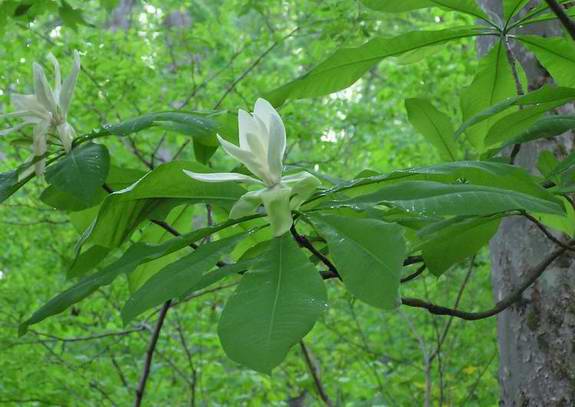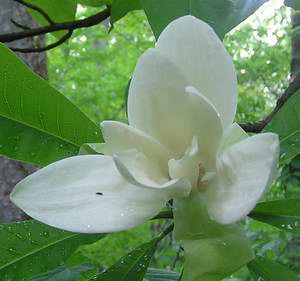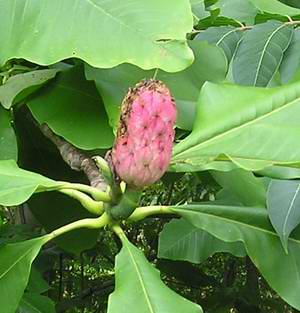|
Return to Hiker's Notebook Home Page
Common Name: Umbrella Magnolia, Umbrella tree, Elk-browse, Elkwood, Japanese magnolia, Wahoo, Cucumbertree - The large oblong leaves emanate from a central attachment like the ribs of an umbrella. Magnolia is the genus name, which in this case is also the common name.
Scientific Name: Magnolia tripetala - The French botanist Pierre Magnol is the eponym for the generic name. The species name refers to the tripetaloid structure of the flower; it has three distinctive petal-like sepals.
The disjointed geographic distribution of the magnolias mirrors their long evolutionary past that has extended over the geologic progression of continental drift, concomitant mountain building orogenies and the climate extremes of extensive glaciation. They are largely tropical in habitat and are found predominantly in east Asia, South and Central America and Africa. There are 11 native magnolia family trees in the temperate regions of eastern North America including the Tulip Poplar (Liriodendron tulipifera) and the Southern Magnolia (M. grandiflora), the epitome of the antebellum South and the state flower tree of Mississippi, the "Magnolia State." Though trees of the family Magnoliaceae are global in scope, they are scattered in areas that became geologically isolated over their long history so that they evolved in independent and separate habitats. This has made their taxonomic classification a tenuous and difficult undertaking.
Though the Magnolia Family has a long history in China and Japan, it was largely unknown to the Europeans until the discovery of the Americas. The shiny green oblong leaves and the fragrant blossoms of the Sweetbay magnolia (M. virginiana) attracted John Banister, a Virginia missionary and amateur naturalist who sent the first specimen to England in 1688,. He named it Laurus tulipfera, the laurel-leaved tulip tree. It was not until 1703 that the French botanist Charles Plumier applied the genus name Magnolia in describing a tree from the French Caribbean island of Martinique. Pierre Magnol is the eponym for the genus. A professor of botany and the director of the Royal Botanical Garden of Montpelier, France, Magnol is considered the inventor of an organization of plant families according to their morphology. The "family tree" concept was further developed by Carolus Linnaeus into the taxonomic system consisting of Latin genus and species names that serve as the fundamental onomastic method of biotic classification . Linnaeus adopted Plumier's genus name Magnolia and used it in the epochal Species plantarum, which established the current genus species taxonomy in 1753. The umbrella magnolia was originally listed as M. virginiana var. tripetala, a variant of the type species M. virginiana; M. tripetala emerged as a separate species in 1759.
Trees of the Magnolia family have long been used for medicinal applications in Asia. In China, an extract from the bark and seeds M. officinalis is called "hou po" and has been used to treat digestive disorders such as diarrhea, abdominal cramping and nausea. The Japanese call it "siaboku-to" and make a tea that is used to treat anxiety. Magnolia family trees produce magnolol and honokiol, two biphenyl compounds that were determined in 2003 to have significant anti-angiogenesis properties - they were effective in preventing the formation of blood vessels. Since cancers grow by producing their own anastomoses of blood vessels, these compounds have anti-cancer potential. Early testing with B-Cell chronic lymphocytic leukemia has demonstrated that honokiol has cytotoxic effects on the cancer cells with very little effect on the normal B-Cells. |

 The
proximate 200 trees and shrubs that make up the family Magnoliaceae are
considered to be among the earliest of the angiosperm flowering land plants,
the largest group of extant seed plants. Primitive or basal angiosperms are
characterized by several features that reflect primeval ecologies and
transitional morphologies. They are generally pollinated by beetles which
preceded bees and other winged pollinators in evolutionary
The
proximate 200 trees and shrubs that make up the family Magnoliaceae are
considered to be among the earliest of the angiosperm flowering land plants,
the largest group of extant seed plants. Primitive or basal angiosperms are
characterized by several features that reflect primeval ecologies and
transitional morphologies. They are generally pollinated by beetles which
preceded bees and other winged pollinators in evolutionary succession. The radially arranged and largely undifferentiated leaflike floral
components are tough and rigid compared to the diaphanous flowers of other
angiosperms to support their coleopteran symbionts. The female organ or
carpel produces seeds with small embryos and a large endosperms to supply
enough nutrition for a long gestation in a primitive environment with few
resources. The fossil record including magnolia-like flowers of the extinct
Archaeanthus confirms the presence of angiosperms in the Cretaceous Period
130 million years ago. Plants of the Magnolia family are estimated to be about
100 million years old.
succession. The radially arranged and largely undifferentiated leaflike floral
components are tough and rigid compared to the diaphanous flowers of other
angiosperms to support their coleopteran symbionts. The female organ or
carpel produces seeds with small embryos and a large endosperms to supply
enough nutrition for a long gestation in a primitive environment with few
resources. The fossil record including magnolia-like flowers of the extinct
Archaeanthus confirms the presence of angiosperms in the Cretaceous Period
130 million years ago. Plants of the Magnolia family are estimated to be about
100 million years old.